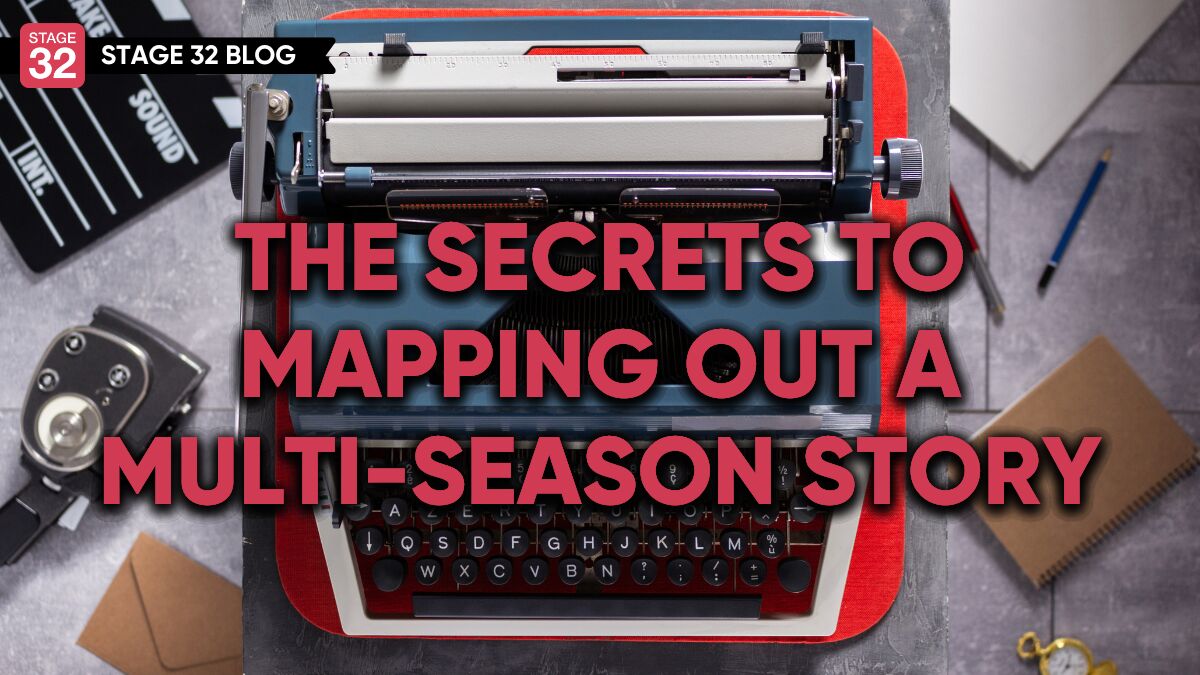The Secrets To Mapping Out a Multi-Season Story
Working with writers as an instructor, consultant, and producer on developing television series, writing pilot scripts, and pitch bibles, I have found that the most exciting – and most difficult – part of the process is imagining that the show is being made and working out what the first season and subsequent seasons might be about. Sure, there will eventually be a writer’s room that will “break” the seasons (decide what happens in each episode), but before that happens, we dream up episodes and craft season arcs that truly bring the show to life. We get to play pretend, as if the show is already sold and we’re ready to call action!
But if in the end that work might be cast aside in the writer’s room, what’s the point of all that effort? It really is one of the most fun things to do in development, but there are also two serious purposes:
- Writing a pilot script is writing the first piece of a long journey. Imagine you are going on a road trip, and you want Google Maps to tell you which way to go. The first step is to turn left or right out of your driveway. If you don’t tell Google Maps what your destination is, it can’t help you make that first turn. If you don’t know where your season is headed, there is no way to write episode one. You might be able to write how the story begins and how the characters pursue their goals against obstacles, but in the last third of your pilot, you will get stuck because you won’t know how to launch your series.
- When people read your pitch bible or listen to your verbal pitch, they are really looking to get your vision for the show beyond the pilot – a series with sustainability. They want to know that you’ve got the steering wheel, that you know all the workings of this show and how to navigate on this road trip. Character descriptions and a unique world are essential, but people really “get” your show when they see what you’ve got planned for the audience along the way.
So let’s take a look at how to map out your story!

STEP ONE - FORMAT
The first thing you have to know is the format of your show because we map out the seasons differently for different types of shows. Going through all the formats and how to do this process for each one would take an entire webinar or a class (good news – there is one of each right here on Stage 32!), but today I’m just going to talk about my personal favorite and the most in-demand right now: ongoing, multi-season shows.
There are also two types of multi-season shows: serialized and episodic. In a serialized show all the storylines continue from episode to episode, even though the pilot and each episode have a temporary resolution at the end. In an episodic “case of the week” series, there is still a season-long arc, but it comes sprinkled in as character development and relationships. The main storyline of each episode is a problem that is resolved within that episode. Most episodic shows are workplace dramas/procedurals of some kind (detective, medical, supernatural, political, etc.) or sitcoms (workplace, family). Sometimes the season-long arc of a procedural consumes so much screen time that it feels as important as the cases – think Grey’s Anatomy – and we have a sort of blend.
STEP TWO – BREAKING THE SERIES
SERIALIZED SHOWS
Good news - you are not expected to know what happens in each episode! In fact, you can’t even know how many episodes will be in your season, because depending on where you sell the show, the network may want 8 or 10 or 12 or even more episodes, and you’re going to say yes to whatever they want. So you’re not going to try to figure out what happens in each episode – which is so hard to do, we have whole rooms full of writers to do it! You just want to pitch the season in broad strokes with some key specifics.
Tips and tricks:
- Lay out the story of the season as a whole story with a beginning, middle, and end. Where do you want to go with the series overall? For Season One, write about 1 – 1.5 pages, but break it into paragraphs. Make sure you include multiple storylines – A, B, C stories.
- If your A, B, C stories run mostly separately, consider not writing out the season chronologically, but organizing the season arc by plotline, or main character, or relationship. How does each storyline “belong” to a main character?
- Don’t try to write scene-by-scene detail or it will seem like you’re outlining an episode and don’t have enough story for a season. But don’t sum up the season in just a few sentences - we need to imagine what episodes of the show will look like.
- What sorts of things do your characters actually do in episodes? Use juicy verbs! What are their motivations? What are the stakes? What is their emotional journey? How do their relationships change? Any new story threads come up after the pilot? Are you adding any new key characters?
- Give a sense of the genre and tone of your show. If your show is funny, you need funny moments. If it’s sexy, you need some romance. If it’s an action thriller, you need some high-octane twists and turns. If it’s a mystery, you need some big surprises.
- KEY TIP: Anyone who is getting a character description in your pitch needs to be a significant player in your season arc. Anyone who is a significant player in your season arc, needs a character description in your pitch. Writing your season will help nail down which characters really matter in your show.
- SUPER KEY TIP: YES, you have to give away the ending!
You’re not pitching your show to your audience – you are pitching it to a buyer, the people who will actually make your show. They need to know what they are buying and that you know what you’re selling. If you were selling a widget, you wouldn’t give the technical specs to the customer, but you’d have to give them to the factory, right? So don’t end sentences with question marks, like “Will they eventually reconcile?” Instead of a “tease,” this always sounds like you have no idea what the answer is and are hoping your buyer will come up with something!

EPISODIC SHOWS
For an episodic series, figure out what sorts of “problems of the week” could happen in your show. Most writers who really have a handle on their episodic series have dozens of potential episodes up their sleeve. Write brief summaries for at least 4 – 6 episodes, though you could go wild and do 8 or even 10. Each of these summaries should be a short paragraph, 3 – 7 sentences (depending on your writing style). Your episodes don’t necessarily have to be “in order” – in fact, I like to put creative episode titles but not episode numbers. Remember, you don’t know how many episodes the network will order – the goal is to make the buyer think they can “crunch all you want, we’ll make more” (TM Doritos).
The secret to a successful episodic series is that you are not selling any one specific story. You are selling a format for episodes, a larger conflict, characters and relationships, and a unique approach or tone. Your episodes serve as illustrations of all the places the show can potentially go.
In a sitcom, the show focuses on a group of characters, and you are selling the “situations,” the conflict between the characters. The problem of each individual episode is solved at the end, but the overall conflict remains. Your storylines are going to be based entirely around the characters but try to give some arc to the relationships. With a workplace drama or procedural, highlight in each episode how your show stands out from the crowd with a unique twist on the genre. Give a sense of how the characters evolve as they confront day-to-day problems and in their private relationships.
Tips and tricks:
- Each episode summary should include the main problem, the characters’ responses, how they interact – and usually make things worse before they make things better. We need to see what sorts of things happen each week, what your characters’ personal goals are in each episode, what obstacles they face (don’t make them too easy!), and what “success” looks like for them.
- Include B-story possibilities in each episode. Are you going to have more than one “case” in each episode? Or the B-story could be the characters’ evolution - accomplishments, milestones, reveals. If the serialized element of the show is pretty thin (think Young Sheldon), then you can probably sprinkle that into the episodes as B-story ideas.
- Make sure your summaries include lots of conflict, especially ways in which the show’s central conflict (story engine) manifests. If your two detectives can’t get along because one is a rogue and the other is by-the-book, they should be knocking heads in each episode in some way.
- KEY SURPRISE TIP: You don’t have to give away the endings! We don’t care that much who the killer is, if the patient lives, if the monster is real, or if they defuse that international crisis. The point is the types of problems, not the specific storylines.
- Many writers with “blended” shows like to write a season arc in addition to their episode summaries. You can do that – just keep it clear and concise. You can use the tips above about serialized shows to show your main characters’ journeys through the major emotional plot points of the season, their entanglements, and changes to relationships. And yes, put in how the season ends!

STEP THREE: SEASONS TWO AND THREE
The bad news is, few shows go beyond three seasons these days, for complicated business reasons. So don’t lay out more than three seasons of your show. If you were dead set on your show being five seasons, my advice is to let it go for now.
For your second and third seasons, you only need to write a paragraph or two for each, focusing on how the show will renew or refocus in each season. Can you offer a different version or view of the world? Maybe the main character has a revised goal? Or maybe a supporting character in season one becomes more significant? Can a key relationship move into a new phase?
KEY TIP: Put the best stories of your show first – don’t “wait” for season 2… or 4 to have the most interesting stories! If Season One doesn’t rock, there will never be a Season Two.
STEP FOUR: PITCHING
If you’re pitching your show in the room (or on Zoom), pitch everything except the pilot! Pitch the main concept, the world, the characters, and the first season. Pitching the entire pilot in detail will land you in the “beat trap” – telling a complicated story too quickly, with the listener walking away with little idea of who and what the series is about. Often the first season tells more about the show than the pilot, and networks nowadays actually prefer to hear about the season, since the executives can just read the pilot script. If you are pitching an episodic show, you might pitch episode one briefly, then pitch a couple more episode ideas.
Mapping out your multi-season story may sound daunting, but I actually think it can be the most fun part of the process of developing a television series. I sometimes think of it like playing a board game – while you’re inventing it. It’s easy to love the end product: a fully developed show, a gorgeous, comprehensive pitch bible, and a pilot that really leaps off the page. But I encourage you to fall in love with the process. Because the ultimate reward for doing well is - more process! If your show sells, you will be plotting story arcs and episode ideas through many sleepless nights, trying to decide how to play a specific scene to set something up for later in the season… before the camera rolls in the morning.
Let's hear your thoughts in the comments below!
Got an idea for a post? Or have you collaborated with Stage 32 members to create a project? We'd love to hear about it. Email Ashley at blog@stage32.com and let's get your post published!
Please help support your fellow Stage 32ers by sharing this on social. Check out the social media buttons at the top to share on Instagram @stage32 Twitter @stage32 Facebook @stage32 and LinkedIn @stage-32
| Advice For Screenwriters From An Award-Winning Producer & Repped Screenwriter |
| A Writer’s Room Special Event: Ask Me Anything with Stage 32 CEO Richard "RB" Botto |
Search Stage 32 Blog
There are now 4035 blog posts for you to enjoy. Search them all by tags below.
Acting, Advice, Cinematography, Coffee & Content, Composing, Contests, Distribution, Featured, Filmmaking, Financing, Inspirational, Networking, Producing, Screenwriting, Success Stories, Tips, Trending,Relevant Tags
Recommended Articles

Stage 32 Featured at the 43rd Torino Film Festival!

November Write Club Week #3: How To Make A Strong First Impression When Meeting Execs, Producers, & Reps

Forbes Spotlights Stage 32 Certification!

How Modern Franchises Became Our New Religion

Wearing Many Hats As A Creative

Coffee & Content: Reinvent the Story, Reinvent the Industry

Insider Intel: The Studio War & The Rise of Indies

7 Life Hacks For Creatives

November Write Club Week 4: The Art of the Pitch- What Managers & Execs Actually Want to Hear






